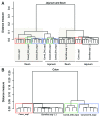The gut microbiota and mucosal homeostasis: colonized at birth or at adulthood, does it matter?
- PMID: 23333858
- PMCID: PMC3595071
- DOI: 10.4161/gmic.23362
The gut microbiota and mucosal homeostasis: colonized at birth or at adulthood, does it matter?
Abstract
The intimate interplay between the gut microbiota and the host may contribute to health and disease in the host. Experiments using conventionalized and conventionally raised animal models have illustrated the role of the intestinal microbiota in shaping and maintaining the host immune system. However, it is still unclear whether colonization at birth or at adulthood induces different host responses. Here, we perform comparative transcriptome analyses to elucidate the impact of the gut microbiota on the development and maintenance of the immune system in adult conventionalized (after 16 and 30 days of colonization) and conventionally raised mice, which were obtained in two independent laboratories. Transcriptional profiles of jejunum, ileum and colon were compared between germfree, conventionally raised mice and conventionalized mice. Germfree mice from the two different facilities clustered together, establishing the validity of the comparative analysis. Nevertheless, significant spatial differences were detected along the gut; the jejunum and colon exhibited a transient response (conventionalized mice) that eventually returned to a homeostatic level (conventionally raised). In contrast, the ileal response to microbiota was similar in conventionalized and conventionally raised mice. Overall, this comparative analysis supports the hypothesis that co-development of the gut microbiota and its host initiates at early stage of development and indicates that despite the achieved homeostasis, immune development is substantially different in mice conventionalized in adulthood. These findings imply that colonization during development is required to meet the window of opportunity where the gut microbiota can imprint the host's mucosal immune-homeostasis in a way that cannot be achieved at later stages in life.
Keywords: comparative analysis; conventionalized mice; conventionally raised mice; germfree adult mice; microbiota; transcriptome.
Figures




References
Publication types
MeSH terms
LinkOut - more resources
Full Text Sources
Other Literature Sources
